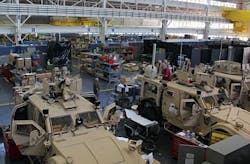Army chooses rugged Ethernet vetronics networking from Sixnet for deploying MRAPs
WARREN, Mich., 26 April 2013. U.S. Army vetronics experts needed rugged Gigabit Ethernet switches for Mine-Resistant Ambush Protected (MRAP) armored combat vehicles headed for Afghanistan. They found their solution from Sixnet in Ballston Lake, N.Y.
Officials of the Army Contracting Command in Warren, Mich., announced their intention last week to award a contract to Sixnet for ET-8MG-MIL-1 rugged Ethernet switches as part the MRAP Capability Set 13 (CS 13) network design. Sixnet is a business of Red Lion Controls Inc. in York, Pa.
The MRAP CS 13 is an integrated group of networked technologies -- including radios, sensors, network switches, and software -- that will deliver an integrated voice and data capability throughout the Army's Brigade Combat Team (BCT) formation, from the brigade commander to the foot soldier, Army officials say.
This contract to Sixnet will be worth an estimated $2.1 million. The number of ET-8MG-MIL-1 Gigabit Ethernet switches ordered from Sixnet was not released. The ET-8MG-MIL-1 switch moves data over Ethernet links at 10, 100, and 1000 gigabits per second.
The Army is ordering the rugged Gigabit Ethernet switches from Sixnet because the company is the only responsible source, and no other suppliers or services will satisfy Army requirements for this MRAP networking installation, Army officials say.
The MRAP CS 13 network design is based on interface to a switch of this the Sixnet ET-8MG-MIL-1 factor and connector scheme, and pursuing an alternate switch at this stage would result in unacceptable delays in fulfilling Army requirements, officials say.
This batch of MRAP vehicles is headed for Afghanistan, and taking the time for an open competition for a rugged vetronics Ethernet switch would delay this deployment, Army officials say. MRAP Capability Set 14 and higher may involve an open industry competition for managed Gigabit Ethernet switches.
The Sixnet ET-8xG-MIL-1 is a fast (10/100/1000) managed or unmanaged industrial Ethernet switch with military-style D38999 connectors, designed as a commercial off-the-shelf (COTS) military solution for battlefield communications, combat vehicles, avionics, shipboard applications that require rugged reliability in extreme environments.
The ET-8xG-MIL-1 has eight fast Ethernet ports for 10/1000-megabit-per-second links; is rated for MIL-STD-810F, MIL-STD-461E, and MIL-STD-1275B standards; has an IP67/NEMA 6 rated package to protect against dust, water, oil, and debris; has military-rated MIL-DTL-38999 series III connectors protect against vibration, shock, and water; comes in a tough corrosion-proof aluminum enclosure; has conductive cooling; and operates in temperatures from -40 to 75 degrees Celsius.
CS 13 is the first integrated group of networked technologies for integrated voice and data capability in the Brigade Combat Team, and is the Army's tactical network baseline to extend the network down to the individual soldier to enhance mission command on the move and soldier connectivity.
The connectivity, architecture, and components of CS 13 were validated at the service's most recent Network Integration Evaluation, NIE 12.2, conducted last summer at White Sands Missile Range, N.M.
The Army's Capability Set fielding plan involves a synchronized vehicle and network fielding plans that ranks capabilities in order of priorities.
Last year the Army completed the MRAP CS 13 final design review to integrate networking hardware and software into the vehicle. MRAPs will be part of the first Infantry Brigade Combat Team (BCT) formations that will be equipped with CS 13.
The first five "super configuration" MRAP prototype vehicles were built last fall at the U.S. Army Tank Automotive Research, Development and Engineering Center in Warren, Mich. The five MRAP super configurations include soldier Network Extension (SNE), Point of Presence Vehicular Wireless Package, MaxxPro and MRAP-Lites.
Each BCT has 373 vehicles, of which there are 42 combinations under the five super configurations to enable the Army to build any combination within each configuration without altering the vehicle, Army officials say.
Other MRAP CS 13 vehicles were built at the Space and Naval Warfare Systems Command (SPAWAR) in Charleston, S.C., and at the Red River Army Depot in Texarkana, Texas. Network verification happened at the Army's Aberdeen Proving Ground, Md.
The Army will field CS 13 to eight Brigade Combat Teams. After fielding CS 13, the Army plans to field as many as six BCT sets of network equipment per year through 2018.
For more information contact Sixnet online at www.sixnet.com, or the Army Contracting Command at www.army.mil/acc.


